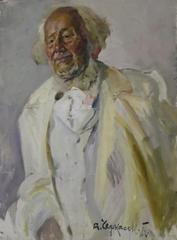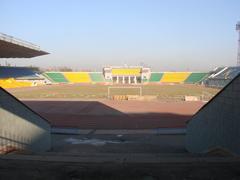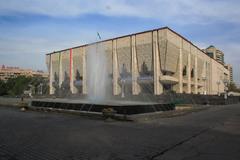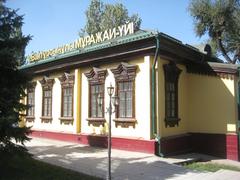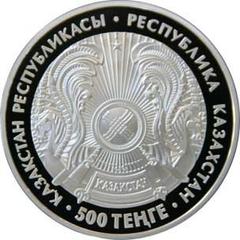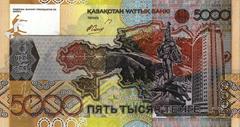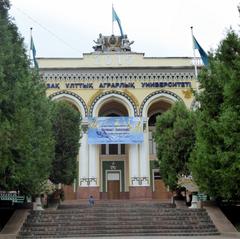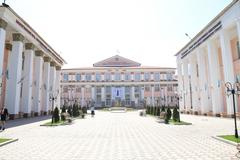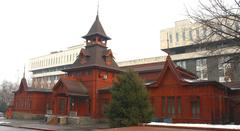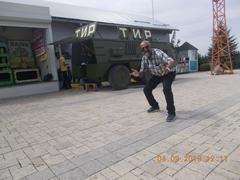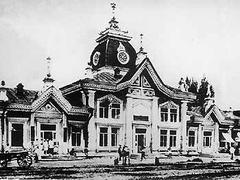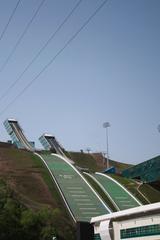Raiymbek Batyr Mausoleum: Visiting Hours, Tickets, and Almaty Historical Sites Guide
Date: 15/06/2025
Introduction
Nestled at the heart of Almaty, the Raiymbek Batyr Mausoleum stands as a revered monument to one of Kazakhstan’s most celebrated heroes, Raiymbek Batyr (1705–1785). Famed for his valor in defending Kazakh lands during the Dzungar invasions, Raiymbek Batyr symbolizes courage, unity, and resilience—qualities central to Kazakh identity. The mausoleum is not only a tribute to his legacy but also an active spiritual and cultural landmark, embodying Kazakhstan’s nomadic traditions and Islamic faith through its distinctive yurt-inspired architecture crowned with a crescent moon.
Since its construction in the early 1990s, the mausoleum has become a significant destination for pilgrims, historians, and travelers eager to delve into Kazakh heritage. Visitors can reflect in its tranquil gardens, explore its symbolic features—including a white camel statue and sacred Quran monument—and enjoy seamless access via public transportation. This comprehensive guide offers insights into the site’s history, architectural symbolism, cultural relevance, and practical visitor information, while also highlighting nearby attractions to enrich your Almaty itinerary (Wikipedia; welcome.kz; ibnbattutatravel.com).
Table of Contents
- History and Legacy of Raiymbek Batyr
- Architectural and Symbolic Features
- Cultural and Spiritual Importance
- Practical Visitor Information
- Nearby Attractions & Suggested Itineraries
- Visitor Tips
- FAQs
- Conclusion
History and Legacy of Raiymbek Batyr
Raiymbek Batyr: Kazakh National Hero
Born into the Alban family of the Elder Zhuz, Raiymbek Batyr rose to prominence amid the 18th-century Dzungar invasions. His title “Batyr” denotes heroism, and legends about his youth—including slaying a Balkhash tiger—cemented his reputation as a fearless warrior. As a military leader under Ablai Khan, Raiymbek played a crucial role in liberating Semirechye (the Seven Rivers region) and uniting the Kazakh zhuzes against the Dzungar threat. His leadership and unity efforts are commemorated in Kazakh literature, poetry, and folklore (Wikipedia; iie.kz).
Evolution of the Mausoleum
Raiymbek’s burial site was venerated for centuries but was destroyed during the Russian Civil War. For decades, only a humble mound marked the spot, surrounded by legends of spiritual protection. A granite stele was installed in 1981, and in 1992–1994, the current mausoleum was built by architects B. Ybraev, S. Agitaev, and Sh. Otepbaev, signaling a renewed national appreciation for Raiymbek’s enduring legacy (Wikipedia; welcome.kz).
Architectural and Symbolic Features
Design and Materials
Completed in 1994, the mausoleum’s polyhedral structure references the traditional Kazakh yurt, symbolizing nomadic roots and communal spirit. Constructed from granite and light-colored stone, the mausoleum’s solidity reflects the steadfastness of Raiymbek’s legacy. The pointed apex and crescent atop the structure mark its Islamic and sacred character, merging Turkic and Islamic traditions (ibnbattutatravel.com; Frontiers of Architectural Research).
Interior and Symbolic Elements
Inside, a central sarcophagus contains Raiymbek’s ashes, and a prayer room welcomes pilgrims. The white camel statue outside references the legend that Raiymbek’s final resting place was chosen by his camel—a symbol of life’s journey and nomadic endurance. A sacred Quran monument, installed in 2005 for Raiymbek’s 300th anniversary, invites visitors to place their hands for blessings. Nearby, a spring is believed to offer healing properties (welcome.kz).
Cultural and Spiritual Importance
The mausoleum is both a historical marker and a living spiritual center. Raiymbek was regarded as an “auliye” (saint), and his burial site is a destination for pilgrims seeking guidance or healing. National commemorations, religious rituals, and literary tributes underscore the mausoleum’s role in shaping Kazakh identity and collective memory. Its location on Raiymbek Avenue and proximity to other landmarks further integrate it into the urban and cultural landscape (Wikipedia; iie.kz).
Practical Visitor Information
Visiting Hours & Tickets
- Hours: Open 24 hours a day, seven days a week, allowing flexible access (ibnbattutatravel.com).
- Tickets: Admission is free; donations are welcomed for maintenance (welcome.kz).
- Guided Tours: Available through local tour operators or by prior arrangement.
Accessibility & How to Get There
- The mausoleum is centrally located on Raiymbek Avenue, easily reachable by car, taxi, or public transport.
- The Raiymbek Batyr Metro Station and several bus routes stop nearby.
- The grounds are mostly accessible to visitors with limited mobility, though some interior spaces may have restricted access. Assistance is available at the site’s information center.
Site Facilities and Etiquette
- Modest dress is recommended out of respect for the site’s spiritual significance.
- Remove shoes before entering the prayer room.
- Photography is permitted outdoors; be discreet indoors, especially during prayers.
- Facilities such as shops, cafes, and restrooms are available in the vicinity.
Nearby Attractions & Suggested Itineraries
Enhance your visit by exploring these notable sites, all within a short distance of the mausoleum:
- Central Mosque of Almaty: One of Kazakhstan’s largest mosques, renowned for its blue dome (Lonely Planet).
- Green Bazaar (Zelyony Bazaar): A vibrant market for local produce and souvenirs (Advantour).
- Panfilov Park & Zenkov Cathedral: A historic park with a unique wooden cathedral (Atlas Obscura).
- Arbat Pedestrian Street: A lively area with shops and cafes (TripAdvisor).
- Kazakh Museum of Folk Musical Instruments: Exhibiting over 1,000 traditional instruments (Lonely Planet).
- Almaty City History Museum: Tracing the city’s evolution (InYourPocket).
- Kok Tobe Hill: Offers panoramic city views, restaurants, and entertainment (Lonely Planet).
- Central Park (Gorky Park): Features amusements, a lake, and a zoo (TripAdvisor).
Sample Itinerary
Half-Day:
- Start at Raiymbek Batyr Mausoleum (30–45 min)
- Visit the Central Mosque (30 min)
- Explore Green Bazaar (45 min)
- Stroll Panfilov Park & see Zenkov Cathedral
Full Day:
- Add visits to the Museum of Folk Musical Instruments, Almaty City History Museum, Kok Tobe Hill, and Central Park.
Visitor Tips
- Best Times: Early mornings and late afternoons offer a quieter experience. Weekends and holidays are busier.
- Weather: Dress for Almaty’s continental climate; spring and autumn are most comfortable.
- Language: Kazakh and Russian are widely spoken; English is common in tourist areas, but a translation app can help.
- Safety: Almaty is generally safe; remain aware in crowded zones such as bazaars.
- Dining: Try local dishes at Green Bazaar or cafes along Arbat Street; Kok Tobe restaurants offer panoramic views.
- Souvenirs: Popular choices include dombras (musical instruments), felt crafts, and local honey.
Frequently Asked Questions (FAQ)
Q: What are the visiting hours of Raiymbek Batyr Mausoleum?
A: The mausoleum is open 24/7.
Q: Is there an entry fee?
A: No, admission is free.
Q: Are guided tours available?
A: Yes, through local tour operators or by arrangement.
Q: Is the mausoleum accessible for people with disabilities?
A: Main pathways are accessible; some interior spaces may be limited.
Q: Is photography allowed?
A: Yes, especially outdoors; please be discreet indoors.
Q: How do I reach the mausoleum?
A: By metro (Raiymbek Batyr Station), bus, taxi, or private car.
Conclusion
The Raiymbek Batyr Mausoleum serves as an enduring symbol of Kazakhstan’s history, spirituality, and architectural innovation. Its open-door policy, central location, and rich cultural context make it an essential destination for anyone seeking to explore Almaty’s heritage. By combining your visit with nearby attractions, engaging respectfully with local traditions, and utilizing convenient transport links, you can enjoy a fulfilling and authentic experience at the heart of Kazakhstan’s cultural capital.
For the latest information, travel tips, and interactive guides, download the Audiala app and follow Almaty’s official tourism resources. Embrace the chance to connect with Kazakhstan’s vibrant past and living traditions at the Raiymbek Batyr Mausoleum (welcome.kz; ibnbattutatravel.com; Wikipedia).
References
- Raiymbek Batyr Mausoleum – Wikipedia
- Raiymbek Batyr Mausoleum – Welcome.kz
- Raiymbek Batyr Mausoleum – Ibn Battuta Travel
- Frontiers of Architectural Research
- iie.kz
- Lonely Planet – Central Mosque of Almaty
- Advantour – Green Bazaar
- Atlas Obscura – Zenkov Cathedral
- TripAdvisor – Arbat Street
- Lonely Planet – Kazakh Museum of Folk Musical Instruments
- InYourPocket – Almaty City History Museum
- Lonely Planet – Kok Tobe Hill
- TripAdvisor – Gorky Park
